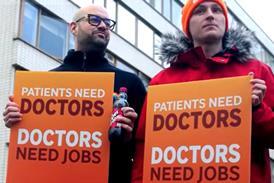Improving emergency care in the long term needs to start with understanding what drives people to accident and emergency, and which behaviours you can change and which you cannot, writes Nosmot Gbadamosi

An important culture change marked the gust of major incidents declared this January. Missed targets and re-admissions became not an acute problem but a collective failure.
Upon looking at its audits, one acute trust that had consistently missed its four hour targets noted: “We had relatively few inappropriate admissions but we had a fair number of unqualified ones.”
Its former chief executive told delegates at the Emergency Care Summit, held in association with the McKinsey Hospital Institute: “That’s quite an important change of language. It wasn’t acute admitting making the wrong decisions but there were other decisions that could have been made for around about a quarter of patients if those other services were available.”
‘The whole system will have to be reconfigured’
While improved patient flow and discharges was key to improving its emergency care, an underlying need remained for something endemic.
“If we want to do anything other than lurch from crisis to crisis, the whole system will have to be reconfigured,” Phil Whitaker declared recently in a piece for the New Statesman.
“The opportunity for community management [of patients] if it existed, has been lost.”
The problem, a senior figure at the department of health argued, is that “we have at the moment people dealing with ‘Monty Pythonesque’ queues for people dealing with body parts.
“You need to create that as part of an integrated response and pool in specialist knowledge to the bespoke benefit of an individual rather than persisting the silos.”
- Newbold: The system level solutions to make urgent care sustainable in the long term
- Take these simple steps to ease A&E pressures in the short term
- Emergency care summit: Sustainability remains A&E’s biggest issue
- Hospital Transformation home
- Join the debate using hashtag #HSJHospitals
The NHS holy grail
This idea of a tailored response was held as the holy grail among delegates at the summit. Around 10 per cent of urgent care admissions are re-admissions within 30 days, said one speaker.
“Perhaps this heavy admissions load is telling us we haven’t quite got that right,” he surmised.
“[For us] we are legitimately discharging people who don’t need inpatient medical care but they still need more than is currently available.”
The group offered a microcosm in end of life care to illustrate this point.
‘The patients that never go home have already been admitted three or fours times in prior weeks’
“If you look at the patients that will never go home, you will see that they have already been admitted three or four times in the prior weeks or months and it touches on the re-admissions,” an acute trust medical director revealed.
“There is something about how we manage end of life because that probably represents… 30 or 40 per cent of medical inpatients at any one time.
“We don’t identify it and we continue to treat them as if they are going to live forever. As a consequence they go home and come back again and we continue to treat until we can’t treat them anymore.
“If we fast forward five years and think where people would go for their healthcare… If you are looking at end of live care and people in nursing homes, then they’d stay in those nursing homes for that care,” agreed the chief executive of an East Midlands hospital. Their trust has seen significant demand on its elective and non-elective activity.
“There would be a much more explicit discussion between them and their families about what they wanted as they moved towards the end of their life.”
What drives people to A&E?
An example from Chichester was brought forward. A former clinical lead at the department of health told delegates: “They realised that a lot of admissions were coming from nursing homes overnight. So they gave them a different number to ring than 999 with a nurse on the end.
“The upshot was a switch from 80 per cent of people dying in hospital to 20 per cent with 78 bed days a month saved,” he explained.
One speaker felt a discussion was also needed on how the myriad of urgent care services available to patients related to each other. Currently, there are various entry points from NHS 111 to minor injuries units.
“My experience of what you might call low level urgent care centres are that they generate a demand which is new, some of which is from general practice but really don’t take an appreciable load of [emergency department],” said one speaker.
‘You should try and understand the motivation’
More broadly, there was consensus that the system needed to start understanding what drives people to use accident and emergency and which of those behaviours you can change and which you cannot.
“Instead of spending time, energy and effort in seeking to educate patients about what is urgent or not, we educate the system to respond rationally within an area to what patients call urgent,” said a former senior figure at the Department of Health.
“Where the population chooses to go to A&E, that’s where you deliver and you don’t try and educate them to do something different, is that what you are suggesting?” asked HSJ editor Alastair McLellan.
One speaker answered: “I don’t think you should try and educate them to do something different but I think you should try and understand the motivation.”
They admitted there are some health economies in the UK where the population is largely made up of people who come from countries that are not used to primary care and they go to the hospital. They pointed to the mobile population in areas like London. “As a GP from Derbyshire, when I came down I was shocked by how many people in London simply weren’t registered with a GP practice,” the delegate said.
Another delegate agreed. An emergency care lead at a children’s trust said: “It’s really nice to say that people are going to stop using A&E because we told them not to but that’s not going to happen because there’s no evidence to prove you can do that.”
De-specialisation
Delegates felt a de-specialised workforce was needed to cope with the rising demand with specialists concentrated only in areas where such expertise was needed.
“The increasing mono-specialisation of hospital doctors has taken us in a direction that is contrary to what the service actually needs,” explained the former chief executive of a long struggling trust.
They said 70 per cent of their trust’s acute work was general but its clinicians were becoming increasingly specialist and coming off the on-call rota.
Another speaker agreed, suggesting “hospitals are currently operating as community services which would require a de-specialising of hospital doctors”.
‘A&E should be a building, not a specialty’
This was acknowledged by many in the room.
“We really need to be able to work with the medical profession both in hospital and out of hospital to actually re-engineer their expectations about what their career is going to look like,” a chief executive of a major acute trust told delegates.
“At the moment we’ve allowed doctors to determine what their career should look like.”
They argued the training of medical staff would need to adapt to meet the needs of the NHS rather than the needs of medical professionals.
Considering these points, delegates began to form what a future A&E geared towards its user’s behaviours might look like.
Whatever we call it, “A&E will be the building, not the specialty” suggested one medical director, adding there would inevitably be a primary care component to it in those areas where patients use A&E for this type of service.
Those individuals would be in the building but within a separate GP listed department which also had out of hour’s capabilities.
Consequently, Mr McLellan noted this chimed with NHS England chief executive Simon Steven’s proposals that any new care vanguard must bring list based general practice into the equation.
Advancing A&E technology
Informatics systems would need to support new structures by making it easier to share information, it was suggested.
Lessons could be learned from the London Underground Oyster card system where individual user history and intelligence data is stored and can be accessed by Underground staff.
The first thing you will see in an A&E when you walk through in 2020 “will be a self-checking kiosk with a little slot for you to put in your NHS card which will carry all your medical records”, suggested a medical director in the West Midlands.
Hyper acute hospitals would link with a range of general hospitals to provide a network of emergency care so that those identified by the ambulance service or GP as having a stroke, heart attack or vascular bleed “would go straight to a specialist emergency service”.
Asked to summarise the group’s vision, one chief executive concluded that “a new ED department in the future would be treating different people; it would have a different workforce to treat them with patients having an [agreed] understanding of their care and are involved in driving their care”.
The way forward
Mr McLellan closed the debate by asking the group whether elements of this future existed within the current system or in other parts of the world.
One speaker pointed to Salford Royal Foundation Trust which already runs three practices as part of a vertical integration system. The Alzira model in Valencia where there is a shared patient record between GPs and specialists was another example.
‘The idea of linking an A&E to a network of feed hospitals exists in many countries’
“Some of these ideas exist somewhere,” suggested Nicolaus Henke, director of McKinsey’s healthcare systems and service practice.
“This idea of linking an A&E to a network of feeder hospitals exists in most countries where there is a population density problem.”
But one profound question is how you fit this jigsaw puzzle. He identified three guiding principles within the group’s long term vision.
- Integrating the multiple levels of A&E.
- The use of technology to prevent those who need support in the immediate future from ending up in A&E.
- To segment the population according to behaviour looking systematically at the various entry points and what kind of experience is provided.
There was trepidation on how likely this new vision could be taken forwards. Fifteen years ago a vision for emergency care reform was developed but is still awaiting implementation, pointed out one medical director.
The Emergency Care Summit was held by HSJ and the McKinsey Hospital Institute on 12 February under Chatham House rules. Speakers’ identities have been protected unless individuals have given permission to make their contributions explicit
Emergency care reform requires a whole system change

Start with understanding motivations
 Currently
reading
Currently
reading
Emergency care reform requires a whole system change
- 2



























3 Readers' comments